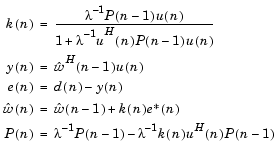

| DSP Blockset |   |
Compute filter estimates for an input using the RLS adaptive filter algorithm.
Library
Filtering / Adaptive Filters
Description
The RLS Adaptive Filter block recursively computes the least squares estimate (RLS) of the FIR filter coefficients.
The corresponding RLS filter is expressed in matrix form as

where  -1 denotes the reciprocal of the exponential weighting factor. The variables are as follows
-1 denotes the reciprocal of the exponential weighting factor. The variables are as follows
The block icon has port labels corresponding to the inputs and outputs of the RLS algorithm. Note that inputs to the In and Err ports must be sample-based scalars. The signal at the Out port is a scalar, while the signal at the Taps port is a sample-based vector.
| Block Ports |
Corresponding Variables |
In |
u, the scalar input, which is internally buffered into the vector u(n) |
Out |
|
Err |
|
Taps |
An optional Adapt input port is added when the Adapt input check box is selected in the dialog box. When this port is enabled, the block continuously adapts the filter coefficients while the Adapt input is nonzero. A zero-valued input to the Adapt port causes the block to stop adapting, and to hold the filter coefficients at their current values until the next nonzero Adapt input.
The implementation of the algorithm in the block is optimized by exploiting the symmetry of the inverse correlation matrix P(n). This decreases the total number of computations by a factor of two.
The FIR filter length parameter specifies the length of the filter that the RLS algorithm estimates. The Memory weighting factor corresponds to  in the equations, and specifies how quickly the filter "forgets" past sample information. Setting
in the equations, and specifies how quickly the filter "forgets" past sample information. Setting  =
=1 specifies an infinite memory; typically, 0.95 


1.
The Initial value of filter taps specifies the initial value  as a vector, or as a scalar to be repeated for all vector elements. The initial value of P(n) is
as a vector, or as a scalar to be repeated for all vector elements. The initial value of P(n) is

where  is specified by the Initial input variance estimate parameter.
is specified by the Initial input variance estimate parameter.
Example
The rlsdemo demo illustrates a noise cancellation system built around the RLS Adaptive Filter block.
Dialog Box
[0,1]. A value of 1 specifies an infinite memory. Tunable.Adapt port.References
Haykin, S. Adaptive Filter Theory. 3rd ed. Englewood Cliffs, NJ: Prentice Hall, 1996.
Supported Data Types
To learn how to convert to the above data types in MATLAB and Simulink, see Supported Data Types and How to Convert to Them.
See Also
| Kalman Adaptive Filter |
DSP Blockset |
| LMS Adaptive Filter |
DSP Blockset |
See Adaptive Filters for related information. Also see a list of all blocks in the Adaptive Filters library.
 | Repeat | RMS |  |